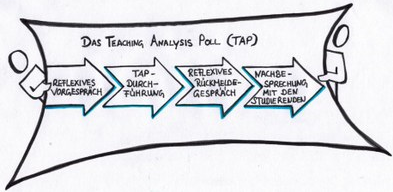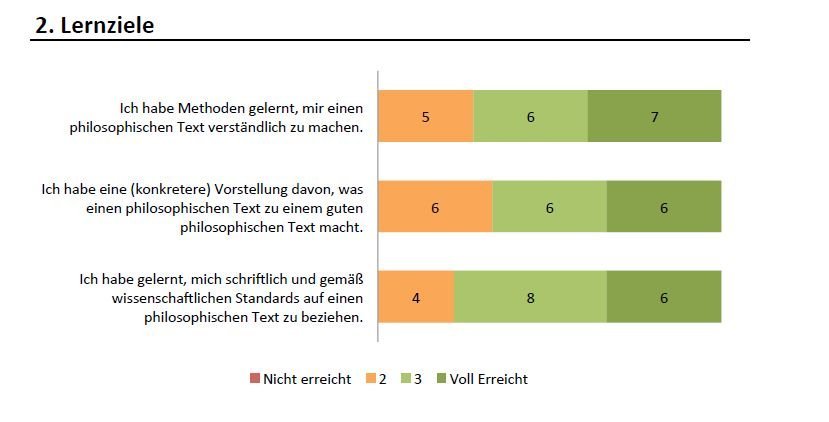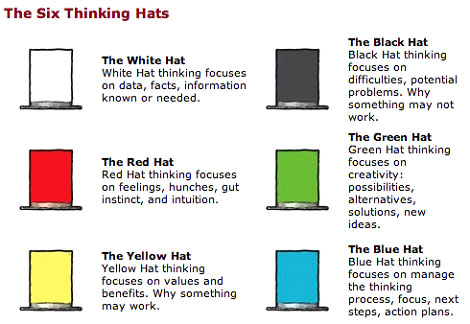
Evaluationsparcours
The aim of an evaluation course is to evaluate an entire study programme and to capture the students' view of their own studies as comprehensively as possible and to use the information gained to derive strategic goals for the respective study programme or faculty.
The evaluation course should provide information on the following areas:
- student perception of the study programme and the students' perspective on it
- student evaluation of the content, course and organisation of studies as well as the general conditions of the study programme,
- student needs and problems during their studies and
- Ideas of the students to support their studies and thus to improve the overall study situation.
In principle, the evaluation course can be initiated by any teacher or administrative staff, for example, also in cooperation with students, and implemented by one or two main persons responsible. However, the implementation should be approved by the dean's office.
First of all, it should be decided to which specific student target group the offer should be directed (which course of studies / which semester).
This is an open, non-moderated workshop, which offers the students an instructive framework through the specification of individual topics. Accordingly, the room should offer enough space to illustrate all topics and a protected atmosphere for the exchange of students.
Altogether 5 main topics are focused and supplemented by 2 open questions. As the 5 main topics each contain several sub-topics, the following possible individual topics can be placed on meta walls:
1. study organisation
- Lecture plan
- Part-time study
- Stay abroad
- Advice, information, support
2. course of study: Contents and Formats
- Block events
- Excursions
- Lectures, seminars, exercises
- Options
- Theory and practice
- Scientific work
3. learning: times, spaces, means
- Learning rooms in the faculty
- Self-study
- Tutorials
- e-learning
- Offers in VL-free time
4. course of studies
- Start of studies and subject maps
- Advice, information, support
- Exchange between the semesters
- Opportunities for co-design
- Work load/substance density
- Internship: preparation, search
5. examinations: Formats and Organization
- Examination formats
- Evaluation phase
- Exam preparation
- Advice and support
In order to enable students to work on the metaplan walls and to be able to evaluate the student answers appropriately afterwards, sufficient markers must be provided. The students can write directly on the meta-walls. There will be no dedicated moderation during the evaluation course. Instead, students work independently and reflect primarily in individual or group work. The role of the organisers is reduced to focusing the students on the content to be worked on and to offer support in case of questions. The students are thus offered a protected and immediately open "space" without far-reaching organizational guidelines or a tight time schedule. This "space" should enable students to reflect on their own studies, either individually or in confidential dialogue with fellow students. They should recognise and formulate their own study-related needs and work out their view of their own degree programme and its organisational framework.
The evaluation course is divided into the following steps:
- Determining the survey target group: 12 weeks in advance
- Consider general conditions at the faculty: 12 weeks in advance
- Set the time and place: 8 weeks in advance
- Inform lecturers of the relevant degree programme: 6 weeks in advance
- Addressing students (specify place and time): 4 weeks in advance
- Organize mini-catering (optional): 1 week in advance
- Organize working materials: 1 week in advance
- Preparing, evaluating and feeding back results: promptly in the Anschluss
Plus/Delta-Evaluation
You can learn a lot about how your students learn in a course and what adjustments you and your students might make by asking your students to give your module a mid-term evaluation. One way to do this is to use a Plus / Delta feedback tool.
The plus / delta feedback tool (sometimes called plus / change) is used to determine what is going well and what needs to be changed. The beauty of this tool is that students need to focus on what they are doing to advance their learning in the module and what could be improved by the teacher and the student. It helps students to reflect on their responsibility for the module and what they should continue to do to learn (PLUS) and what they need to change to make the module better for them (DELTA) (Helminski & Koberna, 1995).
This is how it works:
Students divide a sheet of paper into quadrants (similar to the table below).
- In the upper left quadrant, the student identifies what helps to improve learning in the module.
- In the lower left quadrant, the student writes down what they are doing to improve their learning in the module.
- In the upper right quadrant, the student identifies what needs to be changed or improved in the module or teaching approach to improve learning.
- In the lower right quadrant, the student identifies what needs to be changed or improved in order to improve his or her own learning.
| PLUS | DELTA |
|---|---|
| What helps me learn in this module? | What changes are needed in this module to improve learning? |
| What do I do to improve my learning in this module? | What do I need to do to improve my learning in this module? |
TAP – Teaching Analysis Poll
TAP is a simple yet effective method for teachers to receive constructive feedback from students on their courses. The aim is to initiate a dialogue on the design of teaching and learning in a specific and action-oriented way.
In advance, we arrange a date for the implementation and discuss the overall process.
The LiT-staff member Kathy Meyer-Ross may take over the last 30-45 minutes of a session of the selected course. During this time, in the absence of the teacher, first in groups and then in the plenary, feedback is sought from the students on the following questions:
- What do you learn most in this course?
- What makes your learning more difficult?
- What suggestions for improvement do you have for the hindering points?
At the end of the group phase, all feedback is read out and students are asked to give a hand signal, depending on their personal agreement. This creates an overall picture of the group.
We will discuss the summarized results at a personal appointment after the survey and, if necessary, discuss design options or weigh up the consequences resulting from the feedback.
Ideally, you will discuss the feedback with the students one week later and e.g. explore which changes are feasible or make certain procedures and intentions more transparent.
Contact
M.A. K. Kathy Meyer-Ross
HDS Coordinator at the HTW Dresden
Faculty of Economics
University of Applied Sciences Dresden Friedrich-List-Platz 1 / Z 605
01069 Dresden
Germany
Phone: +49-(0)351-462 2554
BiLOE
The Bielefeld Learning Goal-Oriented Evaluation (BiLOE) is an instrument for the evaluation of courses that you can use on your own without help. You can find out which goals the students pursue in your course. In addition, the students themselves assess whether they are achieving the learning goals of your course. The students are the center of attention. They provide you with feedback on which activities students find helpful in achieving various learning goals and which activities they do not.
With a BiLOE, you can specifically check whether study activities and learning goals harmonize. The BiLOE promotes reflection on teaching and learning on the part of both teachers and students. For the BilOE questionnaire, you define your learning goals for your course. You also specify the activities that you believe will help students achieve the goals (e.g., taking notes, reading, doing exercises, conducting experiments, etc.). When working through the BiLOE sheet, students evaluate the relevance of the learning goals for themselves and formulate their own goal. They also assess which of the study activities helped them to achieve the respective learning objective or give reasons why they did not achieve a learning objective.
For a BiLOE, you must formulate the learning objectives and study activities for your course yourself. You can conduct the BiLOE as a paper pencil or online survey.
Since it is recommended to discuss the learning goals and activities with the students, you should plan the BiLOE for a course at the beginning of the semester. In addition, you should ideally conduct a BiLOE during the course so that you can still discuss the results with the students.
Helpful links:
www.uni-bielefeld.de/einrichtungen/zll/hdle/evaluation/biloe/Beispiele_Lernziele.pdf
www.uni-bielefeld.de/einrichtungen/zll/hdle/evaluation/biloe/Lernziele_Verben.pdf
www.uni-bielefeld.de/einrichtungen/zll/hdle/evaluation/biloe/Beispiele_Studienaktivitaten.pdf
www.uni-bielefeld.de/einrichtungen/zll/hdle/evaluation/biloe/Beispiele_Studienaktivitaten.pdf
Further reading:
- Frank, Andrea (2017). Goal achieved? Students reflect on teaching and learning. German university newspaper 05/2017.
- Frank, Andrea & Kaduk, Svenja (2017). Learning in the focus of course evaluation. Teaching Analysis Poll (TAP) and Bielefelder Lernzielorientierte Evaluation (BiLOE). In W.-D. Webler & H. Jung-Paarmann, H. (eds.), Zwischen Wissenschaftsforschung, Wissenschaftspropädeutik und Hochschulpolitik. University didactics as a living workshop (pp. 203-218). Bielefeld: Universitätsverlag Webler.
- Frank, Andrea & Kaduk, Svenja (2017). Course evaluation as a starting point for reflection and change. Teaching Analysis Poll (TAP) and Bielefeld Learning Goal Oriented Evaluation (BiLOE). In Working Group Evaluation and Quality Assurance of the Universities of Berlin and Brandenburg and the Free University of Berlin (ed.), QM-Systems in Development: Change (or) Management? Proceedings of the 15th Annual Conference of the Working Group Evaluation and Quality Assurance of Higher Education Institutions in Berlin and Brandenburg on 2/3 March 2015, Freie Universität Berlin (pp. 29-51).
- Frank, Andrea; Fröhlich, Melanie & Lahm, Swantje (2011). Interim evaluation during the semester: changing courses together. Journal for Higher Education Development, 6 (3), 310-318.
Contact and support:
M.A. K. Kathy Meyer-Ross
HDS Coordinator at the HTW Dresden
Faculty of Economics
University of Applied Sciences Dresden Friedrich-List-Platz 1 / Z 605
01069 Dresden
Germany
Phone: +49-(0)351-462 2554
The six thinking hats
I discovered The Six Thinking Hats by Edward de Bono (see 1999) as a feedback method for me. By feedback I mean ensuring that what has been learned is understood by the learner and to experience how certain didactic methods and tools that I use are received and evaluated by the student.
In a kind of role play, each student can symbolically put on each of the six hats in different colours and express his or her opinion, perception, emotion or positive/negative criticism without losing face.
First I put on the blue hat, the one of the organisation, and explain the hats. Usually I start with the white hat and collect facts: What have you learned (up to now) / in the course / in the semester and use it to see if I have reached my set teaching/learning goal. The black hat collects negative and the yellow hat positive criticism: What did you not like at all or very well? How do you criticize the theory? How do you classify what you have learned? The red hat collects emotions and can distinguish between I and you messages. Here misunderstandings on the relationship level can be clarified and the green hat looks into the future: What should absolutely remain the same, and more importantly: what is possible (more)? What else do we want to achieve/learn/create?
Flashlight
The flash is used to get feedback at the end of the lecture. Classical questions for a flashlight round are
"What is my mood now?",
"What is my experience with the subject?"
"What is the most important thing I take away from this lecture?".
The question will be written to by the teacher. A flash round has the following rules: Each participant may only say a maximum of one sentence or word to the question. Otherwise it is no longer a flash. There is no discussion during the flashlight round, but the moods and opinions remain the same. Also the teacher is not allowed to ask questions during the round. The teacher can participate in the question about the mood. After the flashlight, the results can be discussed. It takes 3-10 minutes depending on the size of the group and the type of participants.
One-Minute-Paper
At the end of a lecture, the lecturer formulates a manageable number of questions on the topic previously discussed. The students have one minute to put their thoughts on paper. The teacher then collects the papers and evaluates them. In the next lecture, open questions and ambiguities are clarified.
5-Finger-Feedback
The students should choose a finger and feedbake it as follows:
The thumb pointing upwards means: "I particularly liked that!"
This gesture is socially very common. Students find a few words about a learning goal and it is then easier for them to get rid of even more feedback, if desired and wanted.
The index finger has an indicative or inquiring meaning. Here students can ask open questions and get rid of them.
The stretched middle finger is also known to us as a socially accepted gesture. What is expected of the students is clear: "I didn't like that so much", or "this needs improvement".
The ring finger needs some explanation. This is where we put our wedding rings (at least in our cultural latitudes). So we show the connection to someone. The students can now indicate what they connect with the contents of the lecture, what they can use what they have learned, how they want to implement the new contents later on, what they take from the lecture.
The little finger is still left. It is quite short. The students point out what was missing, where they would like to go deeper, which contents they would like to hear more about next time.








